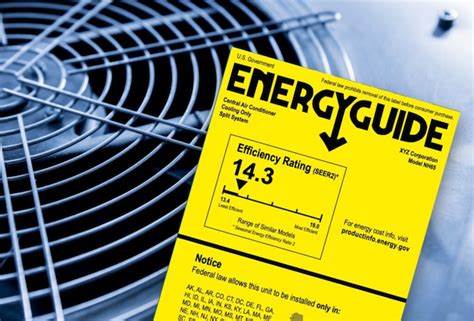HVAC systems, often overshadowed by the flashier elements of home comfort like smart thermostats and high-tech air purifiers, hold their ground with the critical yet understated role of the SEER rating. This measure, the Seasonal Energy Efficiency Ratio, stands as the cornerstone of an HVAC system’s efficiency, blending seamlessly into the background yet significantly impacting performance and cost-effectiveness. This unique aspect differentiates SEER ratings in the broad spectrum of HVAC considerations, marking it as a pivotal factor in understanding and choosing your system.
The spectrum of SEER ratings spans from the basic to the highly efficient, including standard models starting at a rating of 13, extending up to the more premium, energy-efficient units boasting ratings of 25 or higher. Delving deeper, each tier of SEER rating encapsulates its own benefits, from reduced energy consumption and lower utility bills to improved environmental sustainability. The subsequent sections will unfold these layers, offering a comprehensive insight into how SEER ratings shape the efficiency, operation cost, and eco-friendliness of HVAC systems, thereby enriching the dialogue on what makes a high SEER rating a valuable choice for homeowners and businesses alike.
What is SEER Rating?

The SEER rating, or Seasonal Energy Efficiency Ratio, is a critical measure that evaluates the energy efficiency of air conditioning units and heat pumps. It calculates this efficiency by determining the ratio of the cooling output of an HVAC system over a typical cooling season, divided by the energy it uses in Watt-Hours. The essence of this metric is to provide a straightforward, standardized way to compare the efficiency of different HVAC systems.
A higher SEER rating signifies a more energy-efficient unit, leading to lower utility bills and a reduced environmental impact over the system’s lifespan. Understanding the SEER rating is essential for anyone looking to maximize their HVAC system’s efficiency while cutting down on operational costs and contributing to environmental preservation.
Why is SEER Rating important?
The SEER rating is pivotal for its profound influence on energy efficiency, operating costs, and environmental impact. A higher SEER rating signifies that an HVAC system operates with greater efficiency, requiring less energy to cool a space effectively. This heightened efficiency leads to lower monthly energy bills, a key consideration for homeowners and businesses looking to optimize their energy expenditures.

Moreover, systems with higher SEER ratings align with environmental sustainability goals by reducing energy consumption and, consequently, the carbon footprint associated with cooling needs. In summary, the SEER rating is a critical factor in making informed HVAC decisions, striking a balance between upfront investment and long-term benefits in cost savings and environmental responsibility.
Determines HVAC Energy Efficiency
A higher SEER rating signifies that an HVAC system operates more efficiently by using less energy to cool your home.
Influences Operating Costs
Systems with high SEER ratings translate to lower energy bills, offering significant cost savings over the system’s lifespan.
Affects Environmental Impact
Efficient HVAC systems with elevated SEER ratings contribute to a lower carbon footprint, supporting environmental sustainability.
How is SEER Rating calculated?
The SEER rating is determined by dividing the cooling output of an HVAC system, measured across a standard cooling season, by the total electrical energy input in Watt-Hours during the same timeframe. This calculation yields a ratio that effectively captures the system’s efficiency at converting electricity into cooling capacity. A higher ratio signals a system that performs better, achieving more cooling with less energy.
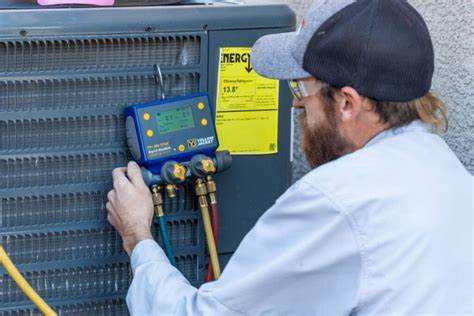
This consistent and standardized metric facilitates direct comparisons between different HVAC models and brands, empowering consumers to make informed decisions that align with their energy efficiency objectives and financial plans.
Cooling Output Divided by Energy Use in Watt-Hours
The SEER rating is determined by dividing the system’s total cooling output by its energy consumption in Watt-Hours.
Calculated Over a Typical Cooling Season
This efficiency calculation is conducted over a typical cooling season, ensuring the SEER rating accurately reflects the system’s performance in standard conditions.
What is a good SEER Rating?
A good SEER rating for an HVAC system is typically in the range of 13 to 25+. Systems on the higher end of this spectrum are more energy-efficient, providing enhanced cooling efficiency with reduced energy use. The minimum recommended SEER rating for new systems is 14, striking a balance between energy savings and cost-effectiveness.
However, the ideal rating may vary based on factors like local climate, home size and insulation, and specific energy savings objectives. In hotter climates, for instance, a system with a higher SEER rating can lead to greater savings on energy bills over time, making it a crucial consideration for achieving optimal efficiency and comfort.
1. Ratings Range from 13 to 25+
SEER ratings span from 13 to 25+, offering a wide range of energy efficiency options for HVAC systems.
2. Higher Ratings Mean More Energy Efficiency
Systems with higher SEER ratings are more energy-efficient, providing superior cooling with lower energy consumption.
3. The Minimum Recommended is 14 for New Systems
For new installations, it’s recommended to choose HVAC systems with a SEER rating of 14 or higher to balance efficiency with cost-effectiveness.
How does SEER Rating affect cost?
The SEER rating significantly influences both the initial purchase price and the long-term operating costs of an HVAC system. Units with higher SEER ratings often have higher upfront costs, reflecting the advanced technology and materials that enable their superior energy efficiency. However, these initial costs can be balanced out by the savings on energy bills over time, as more efficient systems require less electricity to maintain comfort levels.
The degree of these savings largely depends on local energy prices and the climate—systems in warmer regions may provide quicker returns on the investment due to higher usage. Thus, when evaluating the cost impact of a SEER rating, it’s crucial to consider the balance between the upfront investment and the potential for ongoing savings and environmental advantages.
Higher SEER Units Have Higher Initial Costs
Units boasting higher SEER ratings are associated with increased initial purchase prices, reflecting the cost of their energy-efficient technology.
Lower Energy Bills Can Offset the Initial Cost Over Time
Investing in an HVAC system with a high SEER rating can lead to significant savings on energy bills, helping to offset the higher upfront cost over the system’s lifespan.
Long-term Savings Vary by Local Energy Rates and Climate
The extent of long-term savings with high-SEER systems is influenced by factors such as local energy costs and the regional climate, with typically warmer areas benefiting from quicker payback periods.
Can I improve my HVAC’s SEER Rating?
Yes, enhancing your HVAC system’s SEER rating is achievable through a few targeted improvements aimed at boosting its efficiency. Regular maintenance, such as thorough cleaning and timely servicing, ensures that your system functions at its best, potentially mirroring the benefits of a higher SEER rating. Upgrading to a high-efficiency air filter can also make a significant difference by lowering the energy required for air circulation.
Furthermore, sealing and insulating ductwork effectively prevents cool air loss, enhancing the system’s overall efficiency. While these measures may not officially alter the system’s SEER rating, they contribute to better performance and lower energy usage, akin to the advantages of a higher-rated system.
Regular Maintenance Optimizes Efficiency
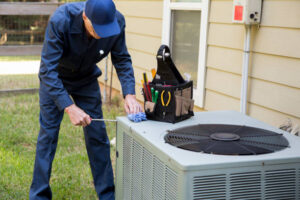
Conducting regular maintenance on your HVAC unit not only ensures its reliability but also optimizes its energy efficiency.
Upgrading to a High-Efficiency Air Filter Can Help
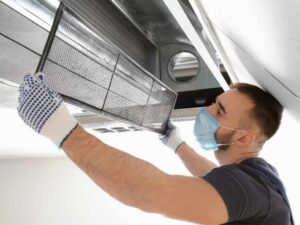
Investing in a high-efficiency air filter can significantly reduce the energy required for air circulation, thereby enhancing the system’s performance.
Sealing and Insulating Ductwork Improves Overall System Efficiency

Sealing and insulating your ductwork effectively prevents cool air from escaping, markedly improving the overall efficiency of your HVAC system.
What should I consider when choosing a SEER Rating?
When deciding on a SEER rating for your new HVAC system, consider the following critical factors to ensure you achieve both energy efficiency and cost savings. The local climate is paramount; areas with higher temperatures may benefit more from systems with a higher SEER rating due to the increased cooling demands. The size and insulation of your home also play a crucial role, as better-insulated homes may not need as high a SEER rating to maintain comfortable temperatures.
Balancing your energy savings goals with the initial cost of the system is another important consideration; while higher SEER ratings typically mean higher upfront costs, they can lead to significant savings on energy bills in the long run. Finally, look into rebates and incentives for energy-efficient systems, as these can help offset the initial investment, making a higher SEER rating more attainable.
Local Climate Impacts the Ideal SEER Rating
The local climate directly influences the ideal SEER rating for your system, with warmer climates necessitating higher-rated units for optimal efficiency.
Home Size and Insulation Affect Efficiency
Both the size of your home and the quality of its insulation are key factors in determining the most energy-efficient SEER rating for your situation.
Energy Savings Goals vs. Upfront Investment
Weighing your energy savings objectives against the initial investment required for a higher SEER rating is crucial for a cost-effective choice.
Rebates and Incentives May Favor Higher SEER Ratings
Seeking out rebates and incentives for energy-efficient systems can significantly offset the cost, making higher SEER ratings more economically viable.
Are there legal requirements for SEER Ratings?
Yes, legal requirements for SEER ratings exist and vary across different regions in the United States. These regulations mandate the minimum SEER rating that new HVAC installations must meet, establishing a standard for energy efficiency. The specific minimum SEER rating differs by geographic location, tailored to local climates and energy consumption patterns.
Moreover, federal laws are periodically updated to reflect advancements in technology and environmental objectives, pushing for higher energy efficiency standards. Compliance with these legal standards is essential when installing or replacing an HVAC system, ensuring adherence to the law while promoting energy savings and environmental benefits.
Minimum SEER Ratings Vary by Region in the U.S.
Minimum SEER ratings are region-specific within the United States, reflecting the unique climate and energy requirements of each area.
New Construction and Replacements Must Comply with Local Codes
All new HVAC system installations and replacements are mandated to comply with local building codes, which enforce the minimum SEER rating requirements.
Federal Laws Periodically Update Minimum SEER Standards
Federal regulations undergo periodic updates to incrementally increase the minimum SEER standards, promoting greater energy efficiency across HVAC systems.
Greater Indoor Comfort with Good HVAC SEER Rating
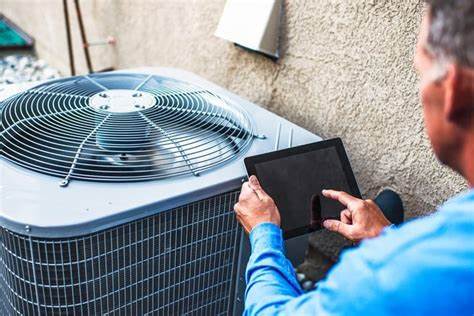
Choosing an HVAC system with a good SEER rating is key to achieving superior indoor comfort. Systems boasting higher SEER ratings not only excel in energy efficiency but also enhance comfort by ensuring consistent indoor temperatures and effective humidity control. These high-efficiency systems often feature quieter operation and improved air quality, incorporating advanced technology that fosters a healthier living environment.
Moreover, they adeptly minimize hot and cold spots, providing a uniformly comfortable space all year round. Thus, opting for an HVAC system with a high SEER rating represents a wise investment in both your comfort and the planet’s well-being, striking a balance between enjoying a pleasant indoor climate and reducing energy use and environmental footprint.
Don’t settle for outdated, inefficient cooling. Contact Callidus Air today for a free consultation and energy efficiency assessment. Our expert technicians can help you navigate the complexities of SEER ratings and find the perfect balance between upfront costs and long-term savings. We’ll show you how a properly sized, high-SEER system can transform your indoor comfort while lowering your utility bills.

